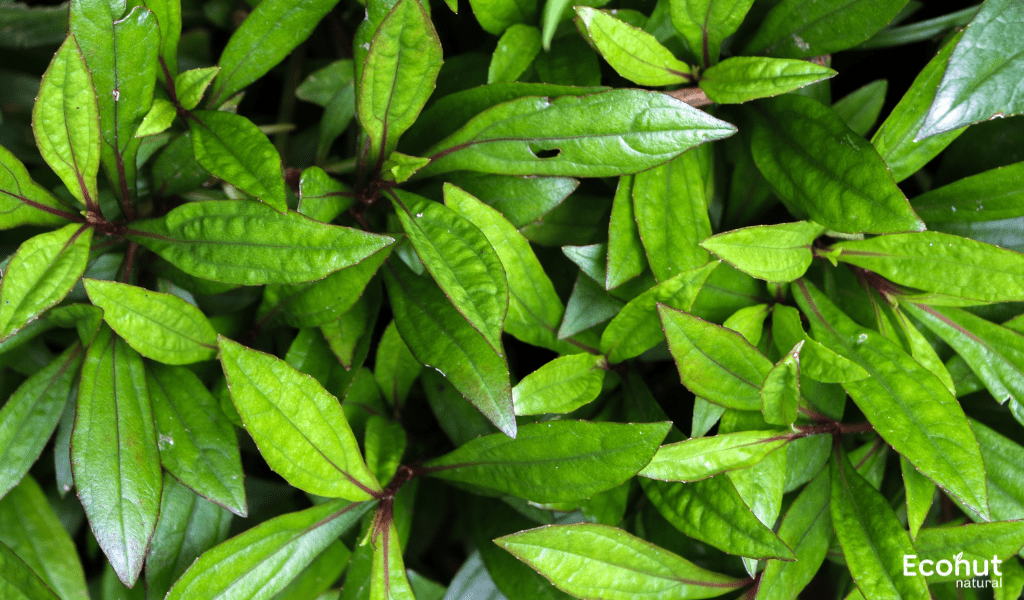The ayapan (Eupatorium Triplinerve) is a perennial, evergreen shrub native to South America. In addition, it grows in Puerto Rico, Hawaii, Ecuador, Brazil, Peru, and India. This typical ornamental plant has a lot of therapeutic uses.
Water hemp is the common name for this shrub, which is native to tropical America. The plant produces long, thin leaves that are used to extract herbal medicines. The stem has a reddish color and is hairless. The leaves are glabrous, purple, and produce corymbose inflorescences.
Description
In English, Ayapan is referred to as Vishalyakarni. It is used to promote blood coagulation and stop bleeding from open wounds. In bleeding piles, stomach ulcer bleedings, bloody diarrhea, or any other region of the body, the leaves and stem are advised.
Botanical Name:
Eupatorium Triplinerve
Family:
Asteraceae
Leaves:
The plant produces long, thin leaves that are used to extract herbal medicines. The stem has a reddish color and is hairless. The leaves are glabrous, purple, and produce corymbose inflorescences.
Flowers:
The Ayapan yields a large number of tiny flower heads that are usually 6 to 13 millimeters in length. A loose arrangement made up of these flower heads is known as a corymb. About 20 distinct flowers, usually characterized as slaty blue or pink in color, make up each head.
Stem:
The smooth, perennial ayapan plant grows to a height of 30 to 60 centimeters. The woody base of the slender, ascending stems creeps and has the ability to root at the lower nodes.
Fruits:
The Ayapan yields little fruits known as achenes when it has finished flowering. These achenes have five angles, a thin oblong shape, and a length of approximately 2 millimeters. Their pappus, which resembles hair and helps with wind dispersal, is a feature.
Habitat:
Native to tropical and subtropical areas of the Americas, ayapan is primarily found in South America’s Amazon jungle. But because of its therapeutic qualities, it has been grown and allowed to naturally occur in many other regions of the world, such as Southeast Asia, Africa, and India.
Parts Used:
Whole plant
Dosage:
- Decoction – 15 to 30 ml
Chemical Constituents
Ayapana oil, a volatile essential oil, makes up 1.14% of the leaves. Together with other chemical components like stigmasterol, vitamin C, and carotene, this oil also contains the coumarins ayapanin (herniarin) and ayapin. Additionally, thymohydroquinone dimethyl ether is present in the essential oil.
Other Language Names of Ayapan (Eupatorium Triplinerve)
Sanskrit name – Ayapama, Ajapama, Vishalyakarni
Bengali name – Ayapan
English name – aipana, cagueña, aypana, aiapana, aiapaina,curia, daun panahan, daun perasman, japana-branca, sekrepatoe wiwir, diapalma iapana, diarana-guaco, japana,pool root, white snakeroot, yapana, Diapana etc.
Hindi name – Ayapan
Malyalam name – Ayappana, Chuvanna kalyonni, Ayambana, Vishapach.
Scientific Classification
| Kingdom | Plantae |
| Order | Asterales |
| Family | Asteraceae |
| Genus | Ayapana |
Ayurvedic Properties
Hindi/Sanskrit
- Rasa -Tikta, Kashaya
- Guna -Laghu,Ruksha
- Virya -Ushna
- Vipaka -Katu
English
- Taste – Bitter, Astringent
- Physical Property – Light, Rough
- Potency – Hot
- Metabolic Property (After Digestion) – pungent
Ayapan (Eupatorium Triplinerve) Uses
- Because of its pitta shamak qualities, aryapan is beneficial for unclogging the intestines and preventing colitis and inflammation. Clear and healthy intestines lead to better skin and easier relief from stomach issues including gastritis, acid reflux, and bloating. It is still possible to administer it to the patient even in cases of severe abdominal distension, including ascites.
- To treat malaria, a decoction produced from the entire plant—including the stem, leaves, and roots-can is used.
- The fresh leaf juice of this plant can be used to treat oral health issues such as stomatitis and gingivitis.
- For the treatment of irregular female menstruation, aryapan is an excellent choice. This characteristic of the plant is ascribed to its ability to balance pitta in the body. The herb’s overall cooling impact supports the female reproductive system and aids in regulating hormonal imbalances.
- The body is generally detoxified by aryapan. It helps detoxify every organ in the body and restore liver function. In this manner, it contributes to the body’s renewal of tissues and cells, extending its lifespan and vigor.
Ayapan (Eupatorium Triplinerve) Benefits
Vomiting:
Increase the amount of warm ayapan panchang decoction (root, stem, leaf, fruit, and flower) to induce nausea and dizziness. The purpose of this medication is to empty the stomach.
Faver:
If someone has cold-related symptoms, boil 20 grams of ayapan leaves in 200 milliliters of water to make a paste. Give him this hot concoction twice or three times a day after that to treat his fever. It works wonders for fever brought on by bile
Piles:
Apply Ayapan ground leaves to the moles in piles and drink 10–20 ml of juice twice or three times a day to get immediate treatment from this illness.
Wound:
If someone has been wounded by a weapon, they should apply is helpful to heal wounds quickly.
Insects poison:
Apply an Ayapan paste to the afflicted area to relieve discomfort.
Ayapan (Eupatorium Triplinerve) Side Effects
Digestive issues:
Ayapan may result in cramping in the stomach, vomiting, diarrhea, or nausea.
Allergic reactions:
In some people, reactions to ayapan allergies include skin rashes, itching, and swelling.
Pregnancy and breastfeeding:
It is not advised for women who are expecting or nursing to use ayapan because its safety has not been shown.
Liver damage:
Ayapan may result in liver damage.
Read Also: Common Rue (Ruta Graveolens) – Uses, Benefits & Side Effects
Conclusion
The tropical American shrub Ayapana triplinervis, sometimes known as water hemp or aya-pana, belongs to the Asteraceae family. The tall, thin leaves of this plant are frequently employed in traditional medicine. The thin, hairless stem is reddish-pink, and the blossoms are pale pink.
FAQS
What are the benefits of Ayapana?
This herb is used medicinally as a diuretic, emetic, expectorant, tonic, antiperiodic, and cardiac stimulant. Additionally, it treats hemorrhages, wounds, ulcers, and snakebites.
What is the use of Eupatorium Triplinerve?
The plant’s leaves are rich in carotene, vitamin C, and ayapanin and ayapin. Applying the paste of the Eupatorium triplinerve leaf or entire plant to newly opened wounds helps stop the bleeding. To stop bleeding and minimize the size of the bleeding exterior pile mass, the leaf paste is applied.
What are the harmful effects of Ayapan?
Blood thinner users should stay away from Ayapan. Coumarin, a strongly fragrant compound found in leaves, has anti-coagulant and blood-thinning effect

